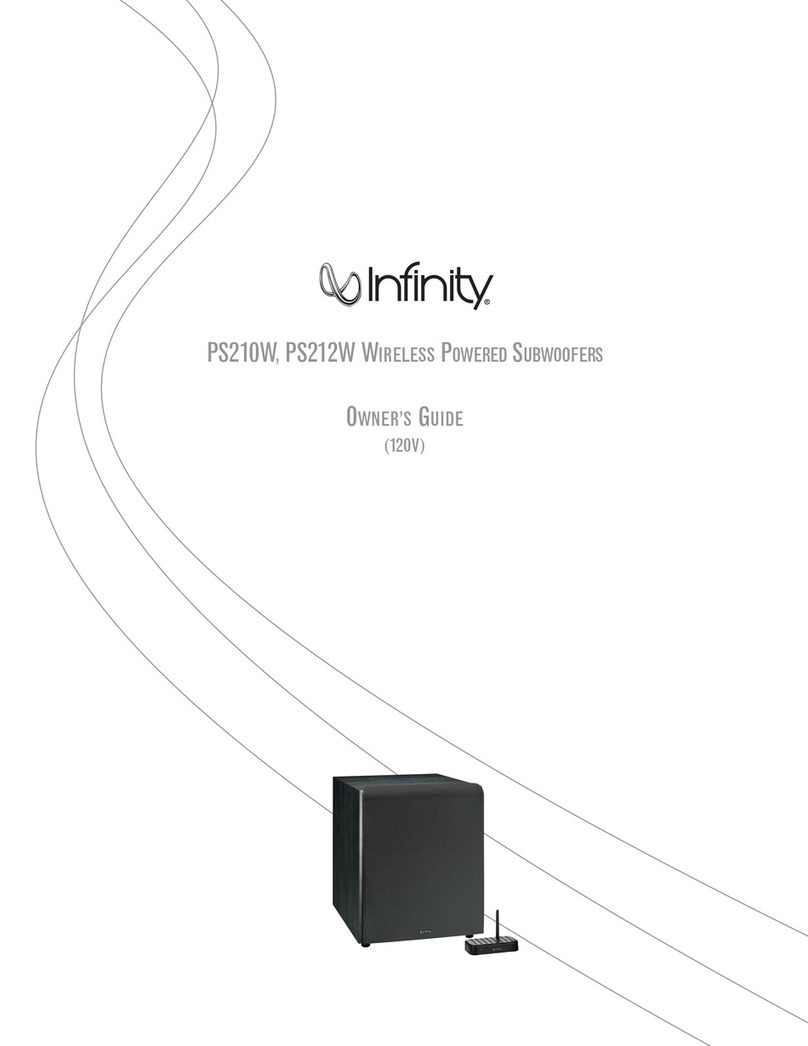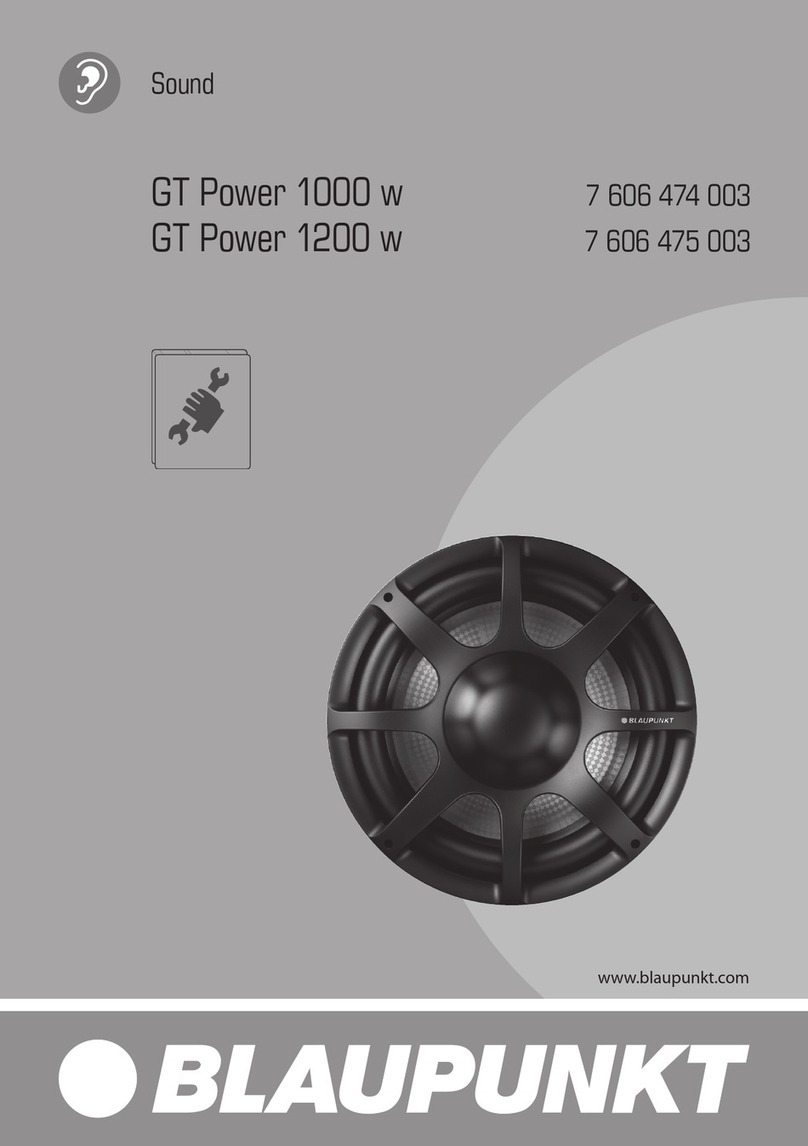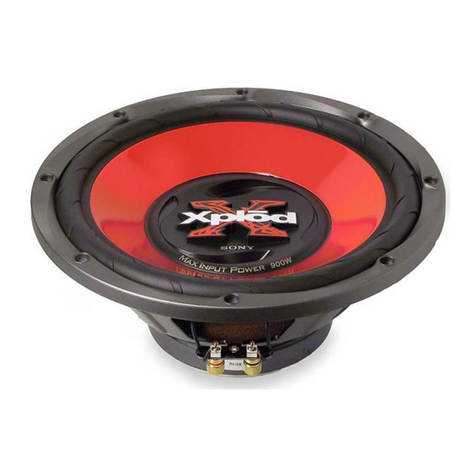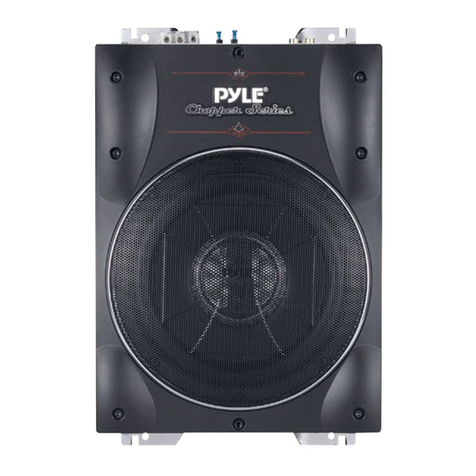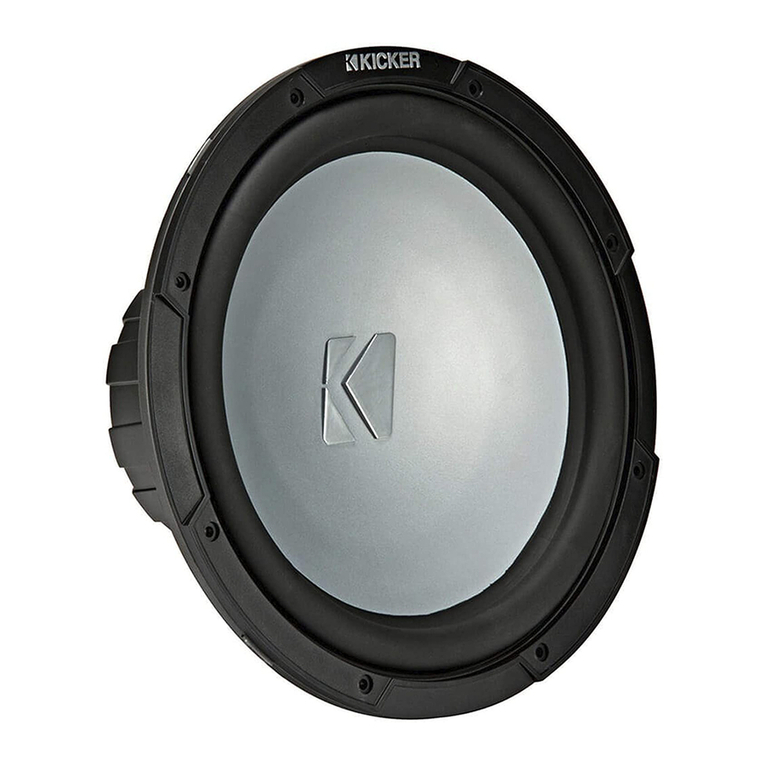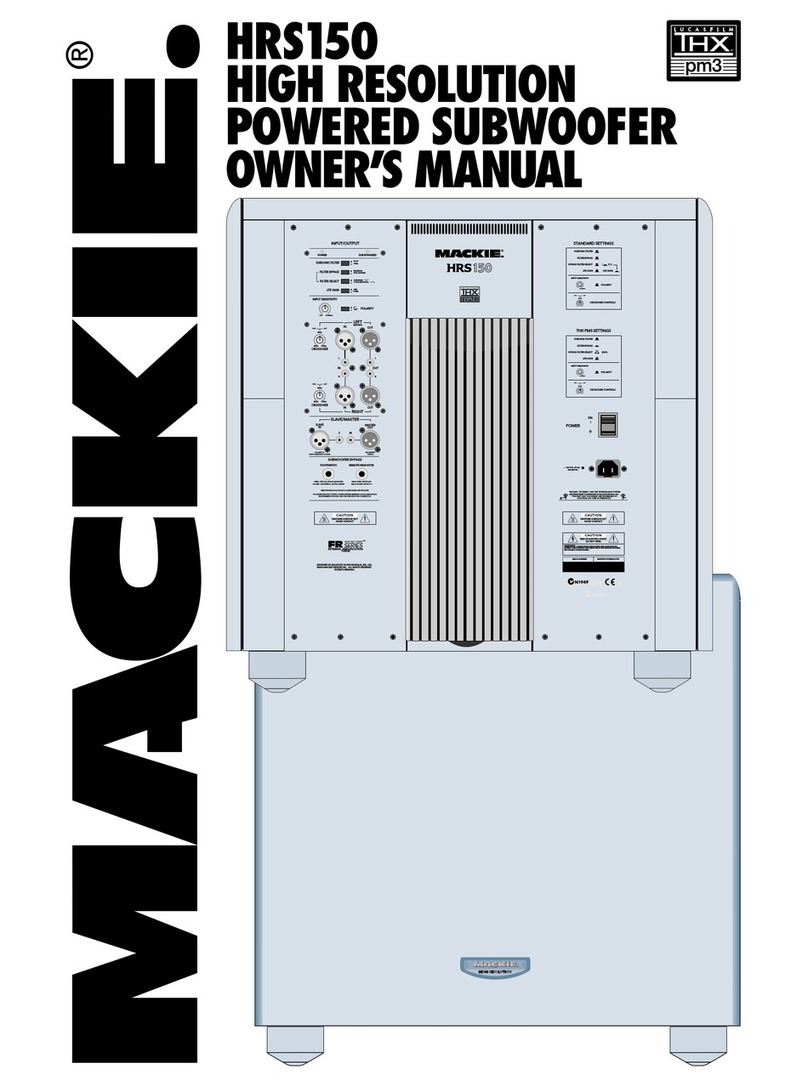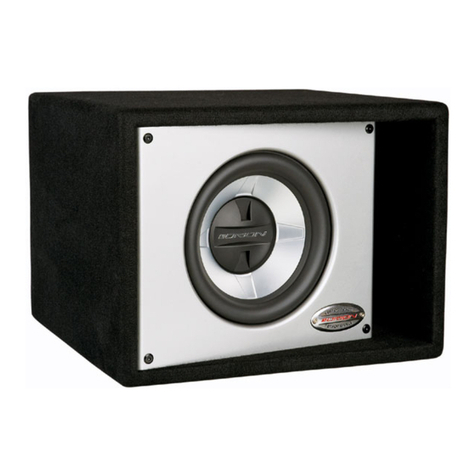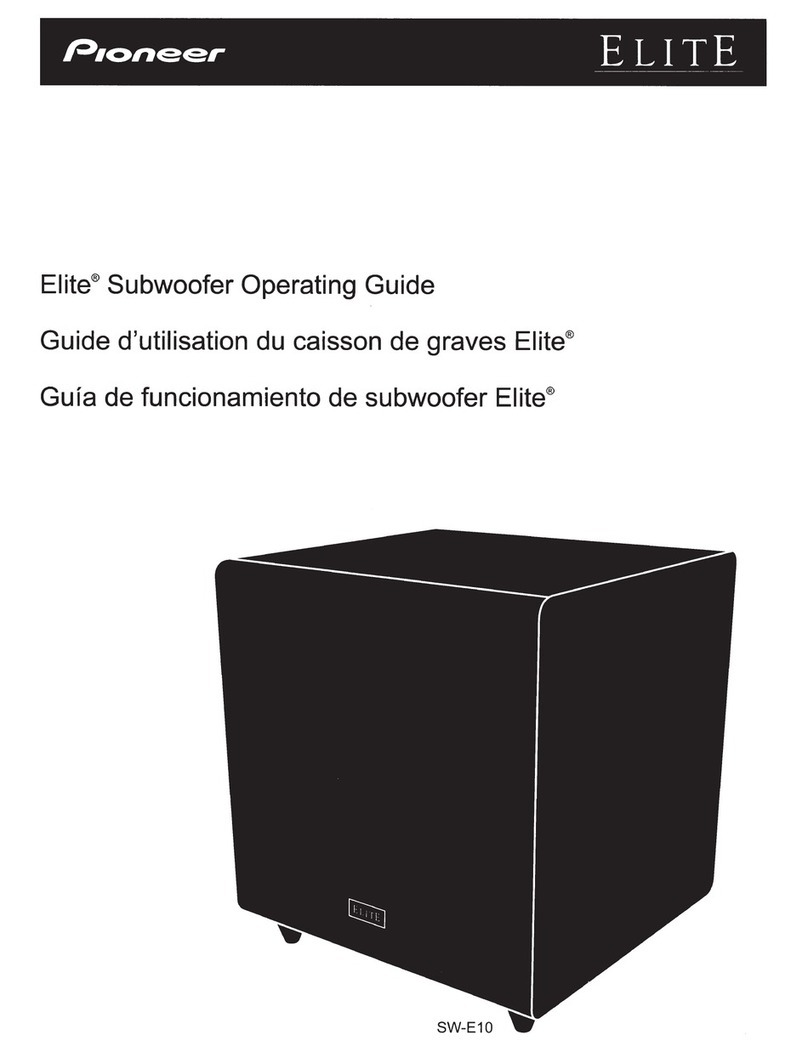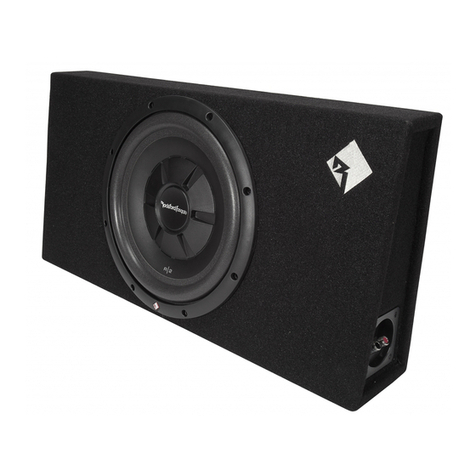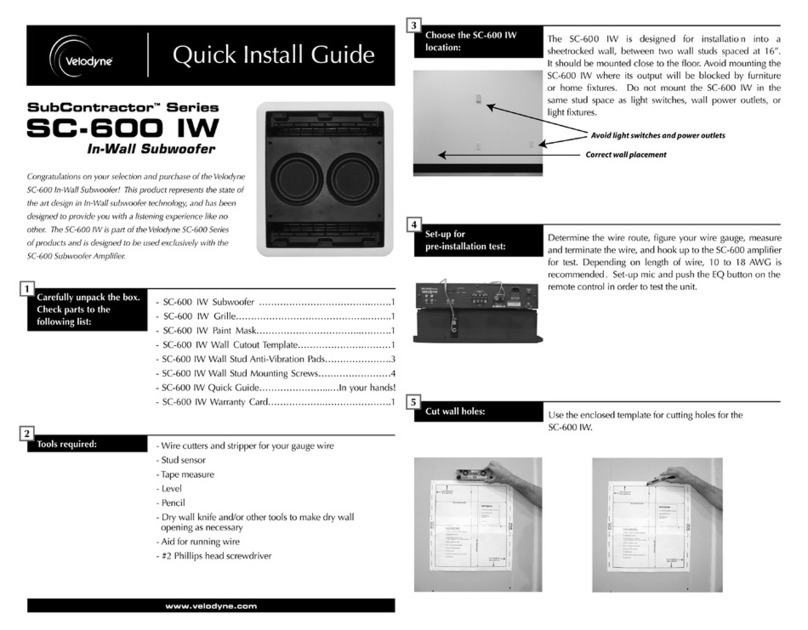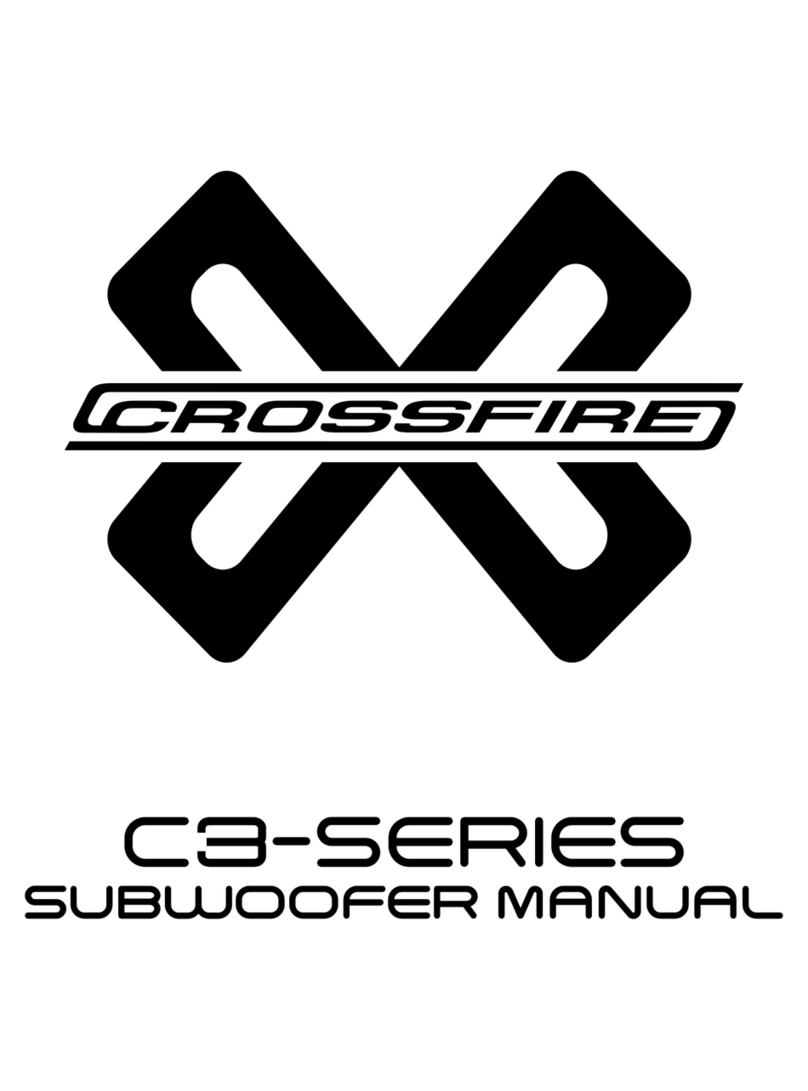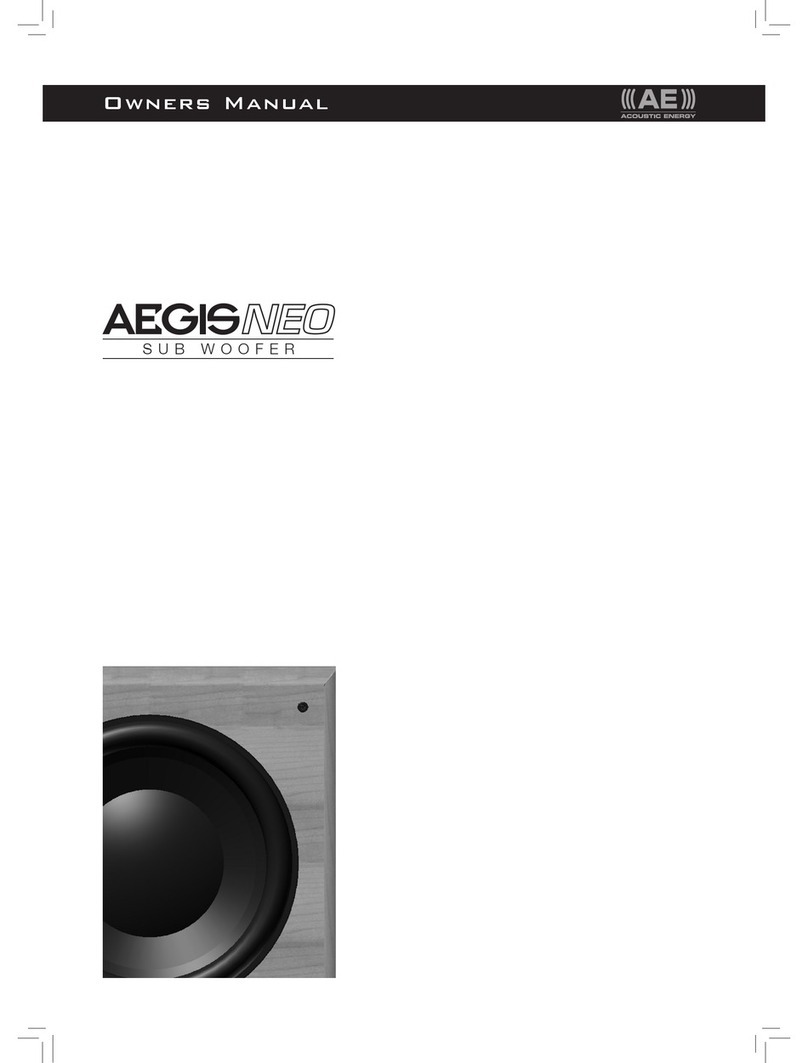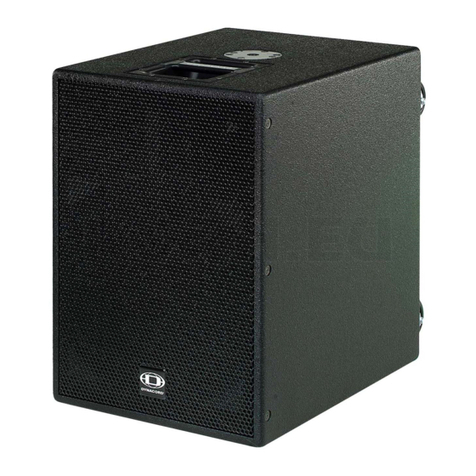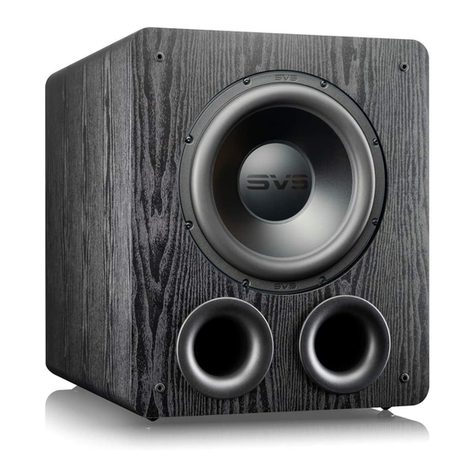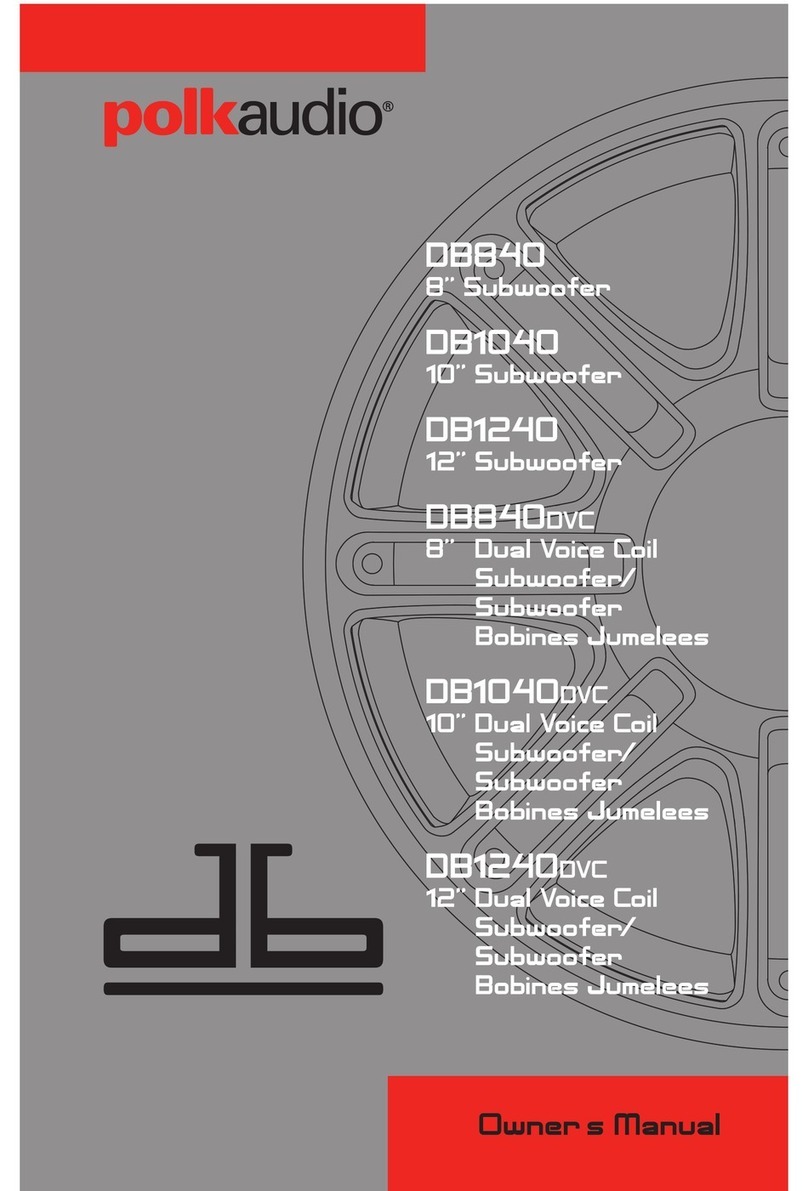Adire Audio RAVA User manual

Rava Owner’s Guide 1
Rava Owner’s Guide 1
Copyright 2001 Adire Audio. All Rights Reserved.
Adire Audio
Rava Owner’s Guide
adire audio
1111 Elliott Avenue W
Seattle, WA 98119
(206)789-2919
http://www.adireaudio.com

Rava Owner’s Guide 2
Rava Owner’s Guide 2
Copyright 2001 Adire Audio. All Rights Reserved.
Introduction
Congratulations and thanks for purchasing the Adire Audio Rava Subwoofer System. This
system was designed to provide high performance audio reproduction in an attractive, small-
sized design. Utilizing our own in-house developed 12” Shiva subwoofer driver, a CNC
machined cabinet, and a built-in 250W amp with crossover, the Rava can meet nearly any
audio reproduction requirement. And with the fine level of finishes available, it will fit in
with nearly any décor.
Great. But how do I pronounce Rava?
Say “Rah-vah”. Think like a cheerleader: Rah Rah Rava!
What makes Rava so much better than other subs?
Simply put, Rava starts with better parts. Fully engineered cabinets. Rugged, powerful
amps. And at the heart of the unit, the Shiva subwoofer driver. The limiting factor in any
subwoofer is the driver, so we started with the finest driver out there: our own Shiva
subwoofer driver.
So what ARE the advantages of the Shiva subwoofer driver over all other
12” subwoofer driver units?
Hmmm, let’s see: longer stroke, lower distortion, stiffer cone, higher power handling, and
better bass extension, to name a few… Shiva was designed with one purpose: to move LOTS
of air, and move it better than any other driver out there.
You see, sound is all about air movement. To reach a louder volume requires more air
movement. To play lower in frequency requires more air movement. Put the two together,
and you see that a subwoofer – which for today’s modern digital music and home theaters is
supposed to play loud AND low – needs to move a LOT of air.
Shiva was designed to have more linear stroke than any other home audio 12” subwoofer
driver out there. How much does it have? Try 1.25” linear stroke, and a peak stroke of 2”.
That’s a LOT of stroke – about 30% (or more) than most other home subwoofer drivers!
And linear motion is what we want. All else being equal, a driver that’s using less of its linear
excursion to generate a given SPL will have lower distortion. Simply put, more linear stroke
means more linear output. More linear output means less distortion. Less distortion means
better sound. So, to sum up, more linear stroke means better sound!
But a subwoofer driver also needs to have a stiff cone. Floppy cones just don’t cut it, as
they don’t move the air linearly. So we need a stiff cone. Now, it’s somewhat “fashionable”
to use metal cones now days; of course, they ring like a bell, too, and when they break up, it’s
not a pretty picture (or sound)! We want a cone to be stiff, but to also avoid nasty
breakups. How do we do this?

Rava Owner’s Guide 3
Rava Owner’s Guide 3
Copyright 2001 Adire Audio. All Rights Reserved.
Paper. Yep, paper. One of the best materials out there for damping cone breakup (avoiding
ringing) is paper. It’s amazingly well damped, which is one of the reasons you see it used a
lot as a base material in some of the best midranges out there. But by itself, paper isn’t
stiff enough. So, we added some neat things: Kevlar(yeah, the bulletproof stuff), and
epoxy. We blended both into the cone. The result? A stiff cone that’s well damped!
OK, I’m convinced Shiva’s the way to go… But how about the amplifier?
What about it? The amplifier is a single-plate unit. It features switchable voltage supplies
(115V/230V so it can be used anywhere in the world), auto-on circuitry, detachable power
cord, variable gain, variable crossover frequency, variable phase, and can output 250W into
the 4 Ωload of Shiva. Plenty to reach home theater levels in most situations (greater than
105 dB SPL continuous).
Want more info about the features of the amp? Well, let’s start with the detachable power
cord. Now, this may not seem like a big deal. But wait until you decide to move the sub to
another room. There’s nothing worse than tripping over a dangling power cord. With Rava,
simply detach the cord, and away you go! Note, too, that it’s a nice standard IEC-type cord
(the same type used with most electronics now days). That means that, if you need a longer
cord (say, 10 feet), it’s easy to run down to your local computer/electronics store and buy a
longer cord. No need to run extension cords every where!
Of course, there’s more than just that. How about auto-on circuitry? That’s right – you can
turn the amplifier on, and leave it on. When it senses a signal, it will “wake itself up”. No
signal for 30 minutes or so, and the amp will shut itself off.
There’s also a variable gain. Set the gain of the sub once to match the rest of your system,
and you don’t have to mess with it again.
Oh, and a variable crossover frequency, too. In fact, the crossover can be varied from 40
Hz to 160 Hz. This means it can blend with just about any speaker system out there.
There’s variable phase, too! Sometimes, you’ll need to adjust the phase of the subwoofer to
get it to properly blend with the rest of your speakers. Rather than “in/out”, you can dial in
any phase angle from 0 to 180 degrees.
Inputs? There’s plenty – and outputs, too! There’s high and low level inputs, and high and
low level outputs. The high level inputs allow you to directly connect the amplifier to the
speaker cables connecting your main speakers. This is VERY handy if you don’t have a
dedicated subwoofer output on your receiver/preamp/processor.
For those with dedicated outputs, then the low level inputs are the way to go. Simply run an
RCA patch cord, and you’re set!
And the high level outputs have a built-in crossover. They’ll high-pass the output at 125 Hz,
first order. Means you don’t have to buy a separate outboard crossover if you want to high
pass your mains.

Rava Owner’s Guide 4
Rava Owner’s Guide 4
Copyright 2001 Adire Audio. All Rights Reserved.
So far so good. Now the cabinet...
Ah, yes, the cabinet. How about some nitty-gritty details: 60L net, after stuffing. The Rava
is built with ¾” CNC machined HDPB, covered with real oak veneer. To finish off, solid oak
quarter rounds are inset in the corners.
The main box is held off the floor by a 2” high base (again, covered in oak veneer). Front
and back are painted with a semi-gloss black, and the driver and front are covered by a full
fabric grille.
Setup
Well, now we’re done with the marketing-speak. On to the details of using this sub system!
The setup of Rava is rather simple: unpack, put in your room, plug it in, hook up to your signal
source, and sit back! Well, maybe not that simple...
Where should I place it?
Where it sounds best! How do you determine this? Well, there’s two ways: a quick and dirty
way, and a more detailed but somewhat more accurate way.
QUICK AND DIRTY: Put it in a corner, behind one of your main speakers.
DETAILED BUT MORE ACCURATE WAY: Put the sub at your listening position. Now play
some music/movies/test tones through it. Walk around the room, listening for a
smooth/even sound to the bass. Check all the corners, middle of walls, and by each end of
the listening chair/couch. Check locations near the floor – yes, this means getting down on
your knees, or lying on the floor. Once you’ve found a location where the sub sounds smooth
and even, switch places with the sub (put it where you were when it sounded best, and you
can go and sit back at your listening position).
What about Break In?
What about it? Give the sub one decent action movie or a rippin’ music CD, and it’s broken in.
Don’t need hundreds of hours, or dozens of movies. Just an hour or two of good bass, and
it’s broken in!

Rava Owner’s Guide 5
Rava Owner’s Guide 5
Copyright 2001 Adire Audio. All Rights Reserved.
Great. It’s in place. Now how do I connect it to the rest of the system?
Connecting Rava will depend upon the type of system you’re going to use it with: processor
with sub out, no sub out with Rava’s built-in high pass speaker level crossover for the mains,
no sub out mains run full range.
PROCESSOR WITH SUB OUT:
PROCESSOR
RAVA
SUB OUTS
LOW LEVEL
INPUT
This is the simple situation. From your processor’s sub output, run an RCA cable to the RCA
line inputs of Rava. Turn on your processor’s crossover, and set it to the lowest possible
frequency. Turn Rava’s crossover frequency to 80 Hz. Enjoy!
NOTE: If your LFE output is a single channel, then you only need one cable from the LFE
output to the Rava. You can use either low level input; left is used by convention.
Additionally, if you need additional gain on the LFE channel, a simple “Y” jack to run the LFE
input to both the left and right channels will give you a “free” 6 dB of gain.

Rava Owner’s Guide 6
Rava Owner’s Guide 6
Copyright 2001 Adire Audio. All Rights Reserved.
NO SUB OUT WITH RAVA’S BUILT-IN HIGH PASS SPEAKER LEVEL CROSSOVER:
PROCESSOR
RAVA
TO MAIN
SPEAKERS
SPEAKER
INPUTS/
OUTPUTS
SPEAKER
OUTPUTS
In this case, you’ll want to use some thick wire from the processor to Rava, and then from
Rava to the main speakers. Rava will do a passive high-level/speaker-level crossover between
the processor and main speakers.

Rava Owner’s Guide 7
Rava Owner’s Guide 7
Copyright 2001 Adire Audio. All Rights Reserved.
NO SUB OUT WITH MAINS RUN FULL RANGE:
PROCESSOR
RAVA
TO MAIN
SPEAKERS
SPEAKER
INPUTS/
OUTPUTS
SPEAKER
OUTPUTS
This is a fairly common connection scheme: the mains and Rava are driven in parallel from
the speaker outputs. Here you don’t need thick wire for Rava, only for the main speakers.

Rava Owner’s Guide 8
Rava Owner’s Guide 8
Copyright 2001 Adire Audio. All Rights Reserved.
How do I dial in the system?
Setting up your Rava subwoofer dials is actually pretty straight forward. It only takes a
few minutes, and goes even faster if you have a friend to help you turn the knobs as you
indicate. But in any case, it’s a fairly simple operation that only takes a bit of listening.
GAIN SETTING
Setting the gain is fairly straight-forward. Put on a signal source you’re familiar with (we
recommend music, but a movie can work as well). Turn the gain all the way down. Now slowly
increase the gain of the Rava amp until it sounds too “loud” in the bass. Back off the gain
setting a bit. There, you’re done!
NOTE: Home Theater processors with variable LFE outputs should use a bit different setup.
In this type of system, set the LFE output of your processor to as low as it will go. Then
turn the gain control on Rava to about ¾ full volume. Then, to adjust your system, use the
LFE output level. This will typically give you the cleanest signal, and the most flexibility in
setting your home theater gains.
CROSSOVER FREQUENCY
Set the crossover frequency all the way down to 40 Hz. Play some music. Slowly increase
the crossover frequency until it sounds too boomy. Then back off a bit. That’s it!
PHASE DIAL
Start with the phase set to zero. now begin turning it until the sub blends right in. This will
result in there being no audible change in sonics from the deepest notes all the way up to
your main speakers – there won’t be an easily definable transition from the main speakers to
the sub. The setting where this is minimized is the place to leave it.
Care
The Rava is built to the highest standards, and was designed to require a minimum of care.
That said, it still needs a little help to stay in peak operating condition for years to come.
All it should take is occasional dusting/polishing with a quality furniture polish. Don’t use the
sub as a step stool, or as a drink coaster, and you should be fine.
Performance
So how good should this units work? Well for the tech-leaning types, here’s the “specs” for
Rava, both anechoic and in-room:
Measurement Anechoic In Room
Frequency Response 27-160 Hz, +3/-3 dB 20-160 Hz, +3/-3 dB
Maximum SPL @ 25 Hz 100 dB SPL 110 dB SPL
Maximum SPL @ 40 Hz 105 dB SPL 114 dB SPL
Maximum SPL @ 60 Hz 110 dB SPL 117 dB SPL

Rava Owner’s Guide 9
Rava Owner’s Guide 9
Copyright 2001 Adire Audio. All Rights Reserved.
Tech Stuff
So, you want to know more about our methods? Well, this is the place to be! Let’s start
with the woofer…
THE WOOFER
The woofers used in Adire loudspeakers are designed for two things: low distortion and wide
frequency extension. We look for a woofer with absolutely minimum distortion in the pass
band, and with as much bass extension as possible while not sacrificing the upper limit. The
woofers used in Adire loudspeakers are from a variety of vendors; each driver is individually
selected to serve its role.
The woofer used in Rava is Shiva, which is custom-built to our specifications. This is a
completely unique driver, which was designed in-house by Adire’s engineering department.
Shiva is an ultra-long throw subwoofer driver, capable of over 1.5L of linear displacement. I
features a Kevlarreinforced epoxy coated paper cone, extra-thick high-compliance UV
treated foam surround, heavy gauge stamped steel basket, 60 ounce magnet, 2” ID 4 layer
voice coil. Rated power handling is 650W RMS. For those real tech-types out there, the
Thiele Small (T/S) parameters are: Fs 21 Hz, Qts 0.39, Vas 151 liters, Xmax 15.9mm one
way, ref efficiency of 87.2 dB SPL @ 1W, 1m. Impressive indeed!
THE AMPIFIER
The amplifier used in Rava is a purpose-built single-plate subwoofer amp. It operates in
class AB, with moderate levels of bias to avoid crossover distortion. It can deliver 250W
into a 4Ωload at 0.5% THD (290W at 1% THD).
The amplifier is self-sealed with a full internal closed cell neoprene gasketing to avoid air
leaks. It features a second order low-pass crossover (Q=0.707) variable from 40 Hz to 160
Hz. Gain is variable over a 30 dB range. Phase is continuously adjustable from 0°and 180°.
The amplifier features a custom EQ network built-in, to extend the bass response of the
subwoofer, while at the same time filtering out power-robbing subsonics (below 16 Hz).
Low-level connections are supplied via RCA connections. The amplifier features a low-level
output via a pair of RCA output connections. This output is full range; it is not crossed over
at all.
High level connections are supplied via binding posts. Up to 8 gauge wire can be
accomodated. High level high pass outputs are supplied via a pair of spring loaded quick-
connects. This high pass output is crossed over at 125 Hz with a first order (Q=0.707)
network.

Rava Owner’s Guide 10
Rava Owner’s Guide 10
Copyright 2001 Adire Audio. All Rights Reserved.
THE CABINET
The sealed cabinet is a net 60L internal volume. It has an effective Qtc of 0.67. The Rava
sides and top are made from HDPB, are covered with real wood veneer on the sides and top,
solid wood stock in the corners. Wood is covered in three layers of sprayed polyurethane.
The front, back, and bottom are painted with a semi-gloss enamel. The grille cloth is matte
black, and the grille covers the entire front of the main cabinet.
PHYSICAL SPECIFICATIONS
Rava
HEIGHT 18 inches
WIDTH 18 inches
DEPTH 18 inches
WEIGHT 65 pounds
POWER CONSUMPTION 450W peak
Warranty
Well, you’ve made it to the Adire Audio Plain English Warranty. We’ll cover any
manufacturing problems for:
•3 years from date of purchase for any materials defect in the driver, amp, or cabinet
•5 years from date of purchase for any labor defect
This warranty covers things that are the direct result of manufacturing problems only! You
connect the low-level inputs to the wall socket, or put a screwdriver through the cone, it’s
not covered. Likewise cigarette burns, cup rings, or other damage from abuse or misuse.
Basically, if you take care of the unit, and treat it in a sane manner (don’t use it as
jackstand, etc.), then you’ve got nothing to worry about.
If the subwoofer is opened, the warranty is immediately null and void. If the driver is
removed, the warranty is immediately null and void.
Any warranty claim must be handled through your original dealer. They’ll inspect the
loudspeaker, and if they determine that the problem may be the result of a material or labor
defect, they’ll send it to us.
We reserve the right to act as the final authority with regard to a valid claim. We reserve
the right to decide to repair or replace any problem that qualifies for warranty work.
Table of contents
